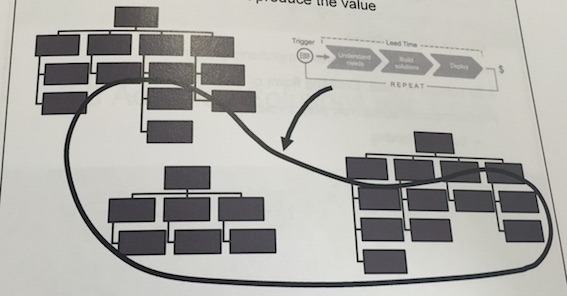I was in a couple of very interesting discussions yesterday, through the mean of a SAFe course. Just sitting in the room with your peers and stakeholders, off-site, discussing how to work more effectively is really powerful - it turns out.
“Who knew?”, he exclaimed with some irony in his voice but still some hope and joy.
Ok, in our discussion I, again, ran into the point where I simply don’t understand the reason for organization your company in a certain way.
I just have to write this down, and see if it becomes clearer for me. You can read it too if you want.
Value streams
We talked a lot about flow and that often our current organizational setup makes flow harder, but the penny dropped around this problem statement when we came to speak about value streams.
I have to say that it’s one of those really vague and fluffy things that I really don’t understand what it is. Or how to find one. Let’s check a dictionary for help
Sequence of activities required to design, produce, and provide a specific good or service, and along which information, materials, and worth flows.
Or simpler:
A sequence of activities where value is created
Where value is created. Value. The reason we are here. Is created along that stream of activities.
In my experience most people I talked to agree with this definition. And that a values stream is useful and present. It’s a good thing (tm)
Breaking down
Where it breaks down for me is when you start to plot out a value stream in a typical organization. Because, in all cases I’ve seen so far, they often look like this:

And to this everyone says: yes, that's how it is. At least in our place. It's a bit funny actually
Quick side note: that’s exactly how projects are created and setup. You pull resources from the normal organization to basically get something done.
Marcus having a “Falling down”-moment
But… what … how can …. if value is created in a value stream and that snakes itself through and organization like some kind of blob shaped amoeba. Then that must mean that our organization is not shaped around our value stream.
Because to get hold of the value stream (where value is created mind you) we have to pull resources high and low.
And still people are nodding in agreement. So I have to ask:
If we are not organized to create value... what are we organized for?
Or even…
If we are not organized to create value... why are we here?
AAAAAAAAAARGH?! WHY ARE WE HERE IF WE DON’T CREATE VALUE FOR ANYONE?!
[Please allow for some time while I collect myself]
[There… I’m good now]
Contrasting
I think that the other paradigm is organized around cost efficiency. The idea is that we want to keep the efficiency and utilization as high as possible in each individual part.
A good example of this is if you have an IT department that the “business” buys service from. Or a operations department where you order actions on your product environment (a ticket for “open the firewall so that I can read logs”).
That’s one strategy. One idea about how we can become our best.
And I’m all against that strategy and all for another, opposing view; flow efficiency.
Let’s contrast them by painting them both in the worst possible way:
Flow efficiency
I don't care what it cost as long as value flows fast to our customer
Resource efficiency
I don't care how long it takes to reach the customer as long as the cost is low
or in fact more commonly (and even more sad)
I don't care about the customer as long as my department is fully utilized
I’ve been to companies where this has been true by design since the middle managers got compensated by the utilization of the employee. 100% -> big bonus.
Conclusion
If you’re strategy is resource efficiency, don’t try to squeeze in agile or lean on top. You will just be sad and there will be a lot of whining and problems that you don’t want to have.
And don’t hire me - I would be miserable.
Although, if you are in that place and want to go towards flow efficiency - lean and agile are GREAT tools to help you find where you should start your improvement work. Lean and agile are problem homing missiles.
Please consider hiring me - I could help you on that journey. But only if you want to do the journey and change what we are doing today. Otherwise you have failed already.
PS Funnily enough most organizations that pursue flow efficiency ends up having low costs and an efficient organization too. But that’s another story